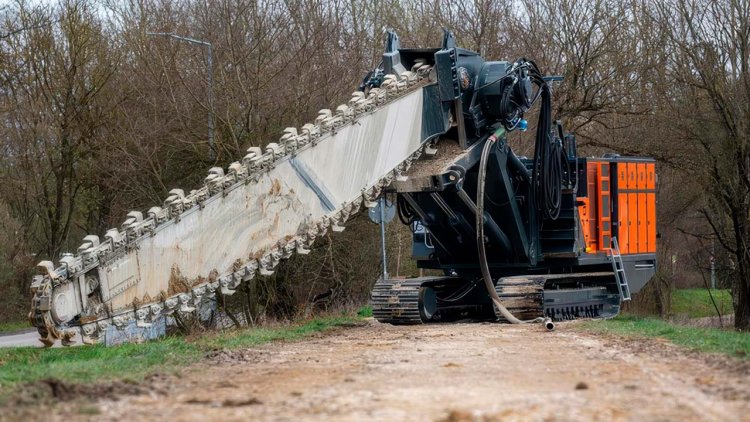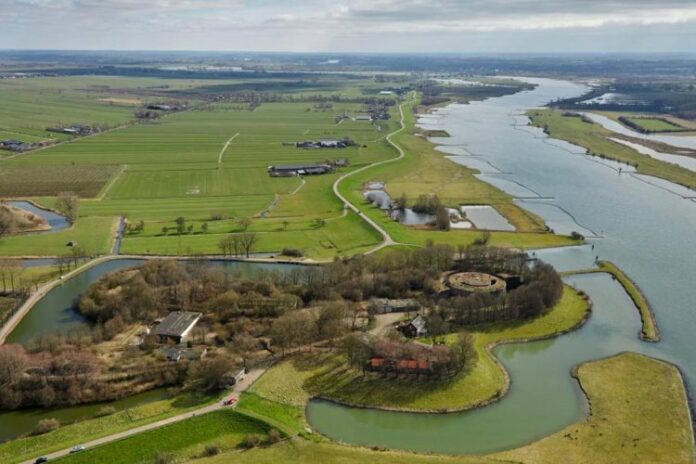The Netherlands is working on the largest dyke reinforcement operation ever since the Delta Works: the Flood Protection Programme (HWBP). More than 1,500 kilometres of dykes will be reinforced over the next 30 years with high ambitions for sustainability and innovation.
To meet this challenge, market players and water boards will have to cooperate. Project Strong Lek Dyke made it possible to investigate the Mixed-In-Place (MIP) method. Van Oord and HITEC Road have partnered to further develop the MIP method, a technique to reinforce dykes in built-up areas in an efficient and sustainable way.
Unlike the usual methods for dyke reinforcement, the MIP method allows a dyke to be reinforced without expanding it. A fantastic solution for a country where space is scarce and where, for example, homes, farms and historical buildings are close to the dykes.
The MIP method is a technique where a milling cutter is used to create a wall in the dyke to a depth of 15 metres below the surface. This wall consists of a mixture of existing soil and binder, such as cement and water. This wall reinforces the dyke in two ways. First, the wall prevents the formation of channels under the dyke that might carry sand particles and therefore weaken the dyke: piping as it is called. Secondly, the wall stabilises the ground, preventing shifting or subsidence of the dyke. Because the existing foundation can be incorporated into the wall, this method is more efficient and sustainable than many other existing techniques such as installing steel sheet piling.

The collaboration between Van Oord and HITEC Road came about as part of the dyke reinforcement programme Strong Lek Dyke, one of the projects of the HWBP (the Lek is one of the branches of the Rhine after it enters the Netherlands). The Strong Lek Dyke programme is divided into 7 subsections reinforcing the Lek Dyke between Amerongen and Schoonhoven over a length of 55 kilometres. Dyke reinforcement is costly and has a major impact on the environment, hence innovation is necessary to realise it. Strong Lek Dyke is a breeding ground for innovations.
This is why, the water board De Stichtse Rijnlanden has opted for the ‘Innovation Partnership’ approach to tender. In the first phase of the project, the water board worked with three Innovation Partners – Van Oord, Mourik Infra and Lekensemble to investigate which innovations could best be applied and developed on a large scale. The MIP method is one of them. Because Strong Lek Dyke consists of subprojects that follow one another, it is more likely that an innovation will make it to the finish line.
The MIP method innovation team drew up a development plan for the Strong Lek Dyke project. The water board gave green light for further development of the MIP technique for the dyke section Culemborgse Veer – Beatrixsluis. Meanwhile, laboratory tests, desk studies and a pilot in Germany have provided insight into what will be investigated and how during a feasibility test in spring 2024 near the Lek Dyke. In the partnership, Van Oord contributes management to this development process and, as a marine contractor, brings knowledge and experience in dyke reinforcement.
HITEC Road, as a specialist in soil stabilisation, brings the equipment, including the milling cutter and product knowledge. The ultimate goal is to make the method usable for future dyke reinforcements in the Netherlands and demonstrate transparency in the technique so that the entire market can work with the innovation. It is only with cooperation and the courage to do new things that innovations can be rolled out from the market on a large scale. Thanks to the partnerships between market players, the water board and HWBP, an innovation like this is possible.



